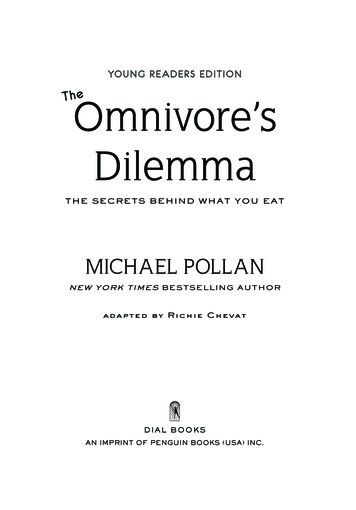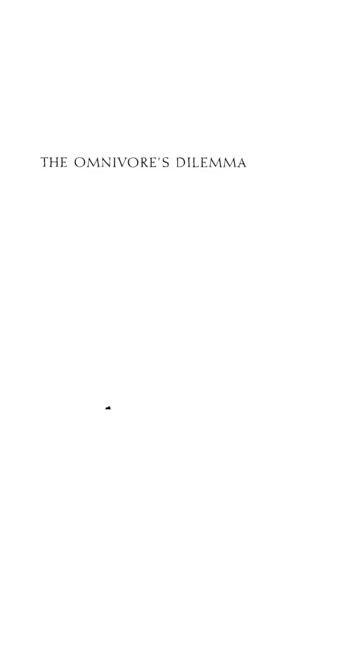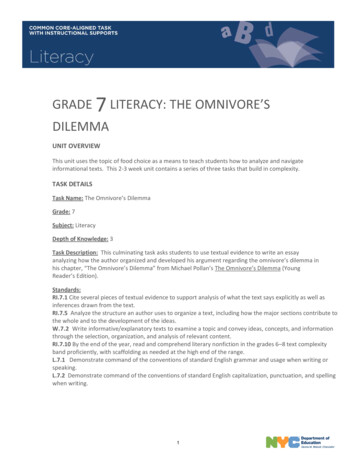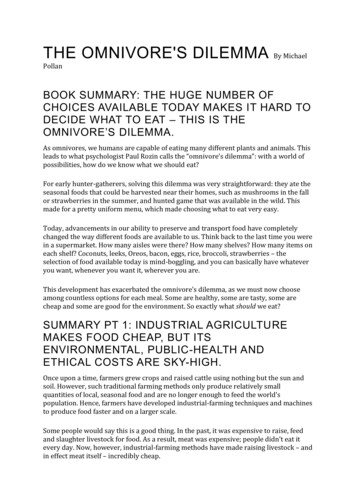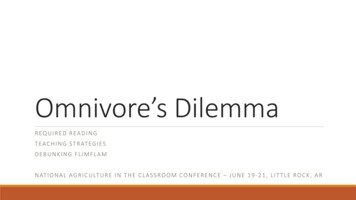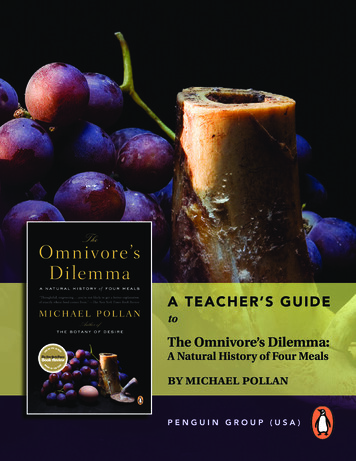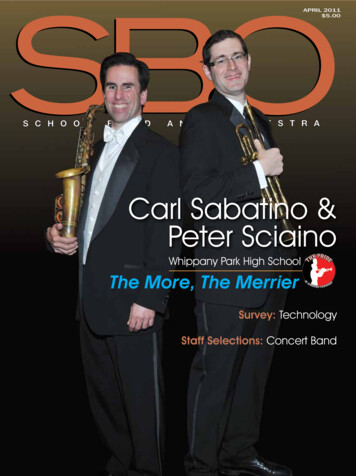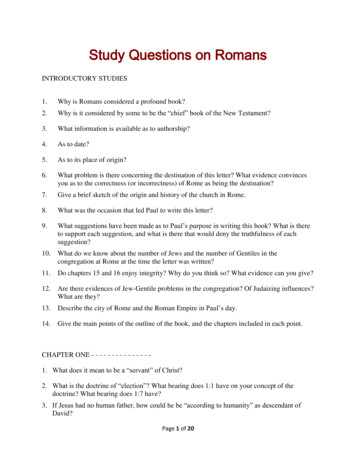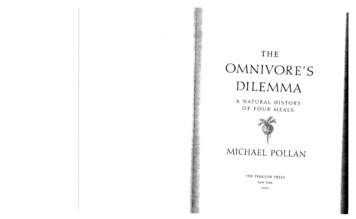
Transcription
THEOMNIVORE'SDILEMMAA NATURAL HISTORYOF FOUR MEALSMICHAEL POLLANTHE PENGUIN PRESSNEW YORK:1006
THE PENGUIN PRESSPublished by the Penguin GroupPenguin Group (USA) Inc., 375 Hudson Street, NewYork, NewYork 10014, US.A. Penguin Group (Canada), 90 EglintonAvenue East, Suite 700, Toronto, Ontario, CanadaM4P 2Y3 (a division of Pearson Penguin Canada Inc.) Penguin Books Ltd, 80 Strand,London WC2R ORL, England' Penguin Ireland, 25 St. Stephen's Green, Dublin 2,Ireland (a division of Penguin Books Ltd) Penguin Books Australia Ltd, 250Camberwell Road, Camberwell, Victoria 3124, Australia (a division of Pearson AustraliaGroup Pty Ltd) Penguin Books India Pvt Ltd, 11 Community Centre, Panchsheel Park,New Delhi - 110 0 I 7, India' Penguin Group (NZ), Cur Airborne and Rosedale Roads,Albany, Auckland 13 I 0, New Zealand (a division of Pearson New Zealand Ltd) Penguin Books (South Africa) (Pty) Ltd, 24 Sturclee Avenue,Rosebank, JohilIDlesburg 2196, South AfricaPenguin Books Ltd, Registered Offices: 80 Strand, London WC2R ORL, EnglandFirst published in 2006 by The Penguin Pressa member ofPenguin Group (USA) Inc.Copyright Michael Pollan, 2006All rIghts reservedLIBRARY OF CONGRESS CATALOGING IN PUBLICATtONDATAPollan, Michael.The omnivore's dilemma: a natural history of four meals / Michael Pollan.p.em.Includes bibliographical references and index.ISBN 1-59420-082-31. GT2850 .P65 2006. 2. Food habits. 3. Food preferences.GT2850.P65 2006394. I 'Z-dc222005056557I. Title.Printed in the United States ofAmerica15 1719 20 18 16 14DESIGNED BY Mi\RYSARAH QUINNWithout limiting the rights under copyright reserved above, no part of thispublication may be reproduced, stored in or introduced into a retrieval system, ortransmitted, in any form, or by any means (electronic, mechanical, photOCOpying,recording or otherwise), without the prior written permission of both thecopyright owner and the above publisher of this book.The scanning, uploading, and distribution of this book via the internet or via anyother means without the permission of the publisher is illegal and punishable bylaw. Please purchase only authorized electronic editions and do not participate in orencourage electronic piracy of copyrightable materials. Your support of the author'srights is appreciated.FOR JUDITH AND ISAAC
INTRODUCTIONOUR NATIONALEATING DISORDERWhat should we have for dinner?This book is a long and fairly involved answer to this seeminglysimple question. Along the way. it also tries to figure out how such asimple question could ever have gotten so complicated. As a culture weseem to have arrived at a place where whatever native wisdom we mayonce have possessed about eating has been replaced by confusion andanxiety. Somehow this most elemental of activitie:r-nguring out whatto eat-has come to require a remarkable amount of expert hclp. Howdid we ever get to a point where we need investigative journalists to tellus where our food comes from and nutritionists to determine the din ner menu?For me the absurdity of the situation became inescapable in the fallof2002, when one of the most andent and venerable staples of humanlife abruptly disappeared from the American dinner table. I'm talking ofcourse about bread. Virtually overnight, Americans changed the wayeat. A collective spasm ofwhat can only be described as carbopho
OUlt NATIONAL EATING DISORDER2. THE OMNIVORE'S DILEMMAbia seized the country, supplanting an era of nationallipophobia datingent and the demonization of another. It would not be apt to confuseto the Carter administration. That was when, in 1977, a Senate commit protein bars and food supplements with meals or breakfast cereals withtee had issued a set of "dietary goals" warning beefcloving Americansmedicines. It probably would not eat a fifth of its meals in cars or feedto layoff the red meat. And so we dutifully had done, until now.fully a third of its children at a fast-food outlet every day. And it surelyWhat set off the sea change? It appears to have been a perfect mediawould not be nearly so fat.Nor would such a culture be shocked to discover that there arestorm of diet books, scientific studies, and one timely magazine article.The new diet books, many of them inspired by the formerly discreditedDr. Robert C. Atkins, brought Americans the welcome news that theycould eat mare meat and lose Weight just so long as they laid off thebread and pasta. These high-protem, low-carb diets found support in ahandful of new epidemiological studies suggesting that the nutritionalorthodoxy that had held sway in America since the 1970s might bewrong. It was not, as official opinion claimed, fat that made us fat, butthe carbohydtates we'd been eating precisely in order to stay slim. Soconditions were ripe for a swing of the dietary pendulum when, in thesummer of 2002, the NewYork ']]mes Magazine published a cover story onthe new research entitled "What if Fat Doesn't Make You Fat?" Withinmonths, supermarket shelves were restocked and restaurant menusrewritten to reflect the new nutritional wisdom. The blamelessness ofsteak restored, two of the most wholesome and uncontroversial foodsknown to man-bread and pasta-acquired a moral stain thatpromptly bankrupted dozens of bakeries and noodle firms and ruinedan untold number of perfectly good meals.50 violent a change in a culture's eating habits is surely the sign ofa national eating disorder. Certainly it would never have happened in aculture in possession of deeply rooted traditions surrounding food andeating. But then, such a culture would not feel the need for its most au to ever deliberate the nation's "dietary goals"--or,for that matter, to wage political battle every few years over the precisedesign of an official government graphic called the "food pyramid:' Acountry with a stable culture of food would nol shell out millions forthe quackery (or common sense) of a new diet book every January. Itwould not be susceptible to the pendulum swings of food scares orfads, to the apotheosis every few years of one newly discovered nutri-other countries, such as Italy and France, that decide their dinner ques tions on the basis of such qUaint and unscientific criteria as pleasureand tradition, eat all manner of "unhealthy" foods, and, 10 and behold,wind up actually healthier and happier in their eating than we are. Weshow om smprise at this by speaking of something called the "Frenchparadox," for how could a people who eat such demonstrably toxicsubstances as foie gras and triple creme cheese actually be slimmer andhealthier than we are? Yet I wonder if it doesn't make more sense tospeak in terms of an American paradox-that is, a notably unhealthypeople obsessed by the idea of eating healthily.ToONE DEGREEor another, the question of what to have for dinner as . sails every omnivore, and always has. When you can eat just about any thing nature has to offer, deciding what you mould eat will inevitably stiranxiety, especially when some of the potential foods on offer are liableto sicken or kill you.This is the omnivore's dilemma, noted long ago bywriters like Rousseau and Brillat-5avarin and first given that nameyears ago by a University of Pennsylvania research psychologist namedPaul Rozin. I've borrowed his phrase for the title of this book becausethe omnivore's dilemma turns out to be a particularly sharp tool forunderstanding our present predicarnents surrounding food.In a 1976 paper called "The Selection of Foods by Rats, Humans,and Other Animals" Rozin contrasted the omnivore's existential situa tion with that of the specialized eater, for whom the dinner questioncould not be simpler. The koala doesn't worry about what to eat:If it looks and smells and tastes like a eucalyptus leaf, it must be dinner.The koala's culinary preferences are hardwired in its genes. But for
4. THE OMNIVORE'S DlLEMMA.omnivores like us (and the rat) a vast amount of brain space and timemust be devoted to figuring out which of all the many potential dishesnature lays on are safe to eat. We rely on our prodigious powers ofrecognition and memory to guide us away from poisons (Isn't !hut themushroom that made mc sick lust weill) and toward nutritious plants (The redberries ore the juicier, sweeter unes). Our taste buds help too, predisposing ustoward sweemess, which signals carbohydrate energy in nature, anda!Nay from bitterness, which is how many of the toxic alkalOids producedby plants taste. Our inborn sense of disgust keepS us from ingestingthings that might infect us, such as rotten meat. Many anthropologistsbelieve that the reason we evolved such big and intricate brains wasOUR NATIONAL EATING DISCthose tasty-looking morsels might lciIl us. (perhaps not as quickly apoisonous mushroom, but just as surely.) Certainly ilie extraordin.abundance offood inAmerica complicates the whole problem of choiAt the SaDle time, many of the tools wiili which people historically rnaaged the omnivore's dilennna have lost their sharpness here--or simIf.illed. As a relatively new nation drawn from many different inlrnigrapopulations, each with its own culture of food, Americans have never ha Single, strong, stable culinary tradition to guide us.The lad of a steadying culture of food leaves us especially vulnerble to the blandishments of the food scientist and the marketer, f,whom the omnivore's dllennna is not 'so much a dilemma as an oppotUn1ty. It is very much in the interest of the food industry to exacerbapreCisely to help us deal with the oIIlll1vore's dilemma.Being a generalist is of course a great boon as well as a challenge; itis what allows humans to successfully inhabit virtually every terrestrialenvironment on the planet. Omuivory offers the pleasures of variety,our anxieties about what to eat, the better to ilien assuage them witnew products. Our bewilderment in the supermarket is no accident; tlreturn of the omnivore's dilemma has deep roots in the modern fuotoo. But the surfeit of choice brings with it a lot of stress and leads to akind of Manichaean view of food, a division of nature into The Goodindustry, roots that, ] found, reach all the way back to fields of corgrowing in places like Iowa.Things to Eat, and The Bad.The rat must make this all-importa:I1t distinction more or less on itsown, each individual figuring out fur itself-and then remembering which things will nourish and which will poison. The human omm vme has, in addition to his senses and memory. the incalculableadvantage of a culture, which stores the experience and accumulatedwisdom of countless human tasters before him. I don't need to experi And so we find ourselves where we do, confronting in the SUpelmarket or at the dimler table the dilennnas of omnivorousness, some cthem ancient and others never before inlagmed. The organic apple or thconvenuonal? And if the organic, the local one or the imported?The wil,fish or the fumed? The trans fats or tlle butter or the "not butter"? Shallbe a carn1vore or a vegetarian? And if a vegetarian, a lacto-vegetarian or.vegan? like the hunter-gatllerer picking a novel mushroom off the for·ment with the mushroom now called, rather helpfully. the"death cap,"and it is common knowledge that that first intrepid lobster eater was onest floor and consulting his sense memory to determine its edibility; w{pid up the package in the supennarket and, no longer so confident 01to something very good. Our culture codifies the rules ofwise eating inan elaborate structure of taboos, rituals, recipes, manners, and culinarytraditions that keep us from haVing to reenact the omnivore's dilennnaour senses, scrul:inize the label, scratching our heads over the meaningof phrases like "heart healthy:' "no trans fats," "cage free:' or "range-fed."What is "natural grill flavor" orTBHQ or xanthan gum? What is all tbisstuff, anyway, and where in the world did it come from?at every meal.One way to think about America's national eating disorder is as the re turn, with an ahnost atavistic vengeance, of the omnivore's dilemma.Therornucopla of the American supermarket has thrown us back on a bewil Mydering food landscape where we once again have to worry tIlat some of werWAGERin writing The Omnivore's Dilemma was that the best way to an the questions we face about what to eat was to go bade to the very
6- THE OMNIVORE'S DILEMMAbeginning, to follow the food chains that sustain us, all the way fromthe earth to the plate-to a small number of actual meals. 1 wanted tolook at the getting and eating offood at its most fundamental, which isto say, as a transaction between species in nature, eaters and eaten. ("Thewhole ofnature," wrote the English authorWilliam Ralph luge, "is a con jugation of the verb to eat, in the active and passive.") What 1 try to do inthis book is approach the dinner question as a naturalist might, using thelong lenses of ecology and anthropology. as well as the shorter, more in timate lens ofpersonal experience.My premise is that like every other creature on earth, humans talepart in a food chain, and our place in that food chain, or web, deter mines to a considerable extent what kind of creature we are. The fact ofour omnivorousness has done much to shape our nature, both bod}possess the omnicompetent teeth and jaws of the omnivore, equally wellsuited to tearing meat and grinding seeds) and soul. Our prodigiouspowers of observation and memory. as well as our curious and experi mental stance toward the natural world, owe much to the biologicalfact of omnivorousness. So do the various adaptations we've evolved todefeat the defertses of other creatures so that we might eat them, in cluding our sltills at hunting and cooking with me. Some philosophershave argued that the very open-endedness of human appetite is respon sible for both our savagery and civility. since a creature that could con ceive of eating anything (including, notably, other humans) stands inparticular need of ethical rules, manners, and rituals. We are not onlywhat we eat, but how we eat, too.Yet we are also different from most of nature's other eaters markedly so. For one thing, we've acquired the ability to substantiallymodify the food chains we depend on, by means of such revolutionarytechnologies as cooking with :fire, hunting with tools, farrrting, andfood preservation. Cooking opened up whole new vistas of edibility byrendering various plants and animals more digestible. and overcomingmany of the chemical defertses other species deploy againsteaten. Agriculture allowed us to vastly multiply the populations of a fewfavored food species, and therefore in turn our own. And, most recently,OUR NATiONAL EATING DiSORDER 7has allowed us to reinvent the human food chain, from thesynthetic fertility of the soil to the microwaveable can ofsoup designedto fit into a car's cup holder. The implications of this last revolution, forour health and the health of the natural world, we are still strugglingto grasp.The Omnivore's Dilemma is about the three principal food chains thatsustain us today: the industrial, the organic, and the hunter-gatherer.Different as they are, all three fOod chains are systems for doing moreor less the same thing: linking us, through what we eat, to the fertilityof the earth and the energy of the sun. It might be hard to see how, buteven a Twinlde does thiSc-i:onstitutes an engagement with the naturalworld. As ecology teaches. and this book tries to show, it's all con nected, even the Twinkie.Ecology also teaches that all life on earth can be viewed as a compe tition among species for the solar energy captured by green plants andstored in the form of complex carbon molecules. A food chain 1s a sys tem for passing those calories on to speeies that lack the plant's uniqueability to synthesize them from sunlight. One of the themes of thisbook is that the industrial revolution of the food chain, dating to theclose of World War II, has actually changed the fundamental rules ofthis game. Industrial agriculture has supplanted a complete reliance onthe sun for our calories with something new under the sun: a foodchain that draws much of its energy from fossil fuels insteadcourse, even that energy originally carne from the sun, but unlike sun light it is finite and irreplaceable.) The result of this innovation has beena vast increase in the amount of food energy av.tilable to our species;this has been a boon to humanity (allowing us to multiply our num bers) , but not an lillalloyed one. We've discovered that an abundance offood does not render the omnivore's dilerruna obsolete.To the contrary,abundance seems only to deepen it, giving us all sorts of new problemsand things to worry about.Each of this book's three parts follows one of the principal humanfood chains from beginning to end: from a plant, or groupphotosynthesizing calories in the sun, all the way to a meal at the din
8 ,-. THE OMNIVORE'S DILEMMAner end of that food chain. Reversing the chronological order, I startwith the industrial food chain, since that is the one that today involvesand concerns us the most. It is also by far the biggest and longest. Sincemonoculture is the halhnark of the industrial food chain, this sectionfoc.11Ses on a single plant: Zeu mays, the giant tropical grass we call corn,which has become the keystone species of the industrial food chain,and so in turn of the modeIll diet.This section follows a bushel ofcom modity corn from the field in Iowa where it grew on its long, strangejOUIlley to its ultimate destination in a fast-food meal, eaten in a mov ing car on a highway in Marin County, California.The book's second part follows what I call-to distinguish it fromthe industrial-the pastoral food chain. This section explores some ofthe alternatives to industrial food and farming that have sprung up inrecent years (variously called "organic," "local," "biological," and "beyond organic"), food chains that might appear to be preindustrial butin surprising ways turn out in fact to be postindustrial. I set out think ing I could follow one such food chain, from a radically innovativefann in Virginia that I worked on one recent sununer to an extrem ylocal meal prepared from animals raised on its pastures. But I promptlydiscovered that no single lIm or meal could do justice to the complex,branching story of alternative agriculture right now, and that I neededalso to reckon with the food chain I call, oxymoronically, the "indus trial organic." 50 the book's pastoral section serves up the natural his tory of two very different "organic" meals: one whose ingredientscame from my local Whole Foods supermarket (gathered there from asfar away as Argentina), and the other tracing its origins to a single poly culture of grasses growing at Polyface Farm in Swoope, Virginia.The last section, titled Personal, follows a kind of neo-Paleolithicfood chain from the forests of Northern California to a meal I prepared(almost) exclusively from ingredients I hunted, gath!'.red, and grewmysel Though we twenty-first-century eaters still eat a handful ofhunted and gathered food (notably fish and wild mushrooms), my in terest in this food chain was less practical than philosophical: I hopedto shed fresh liQht on the way we eat now by inunersing myself in theOUR NATIONAL EATING Dl50RDEIway we ate then. In order to make this meal I had to learn how to dosome unfamiliar things, including hunting game and foraging for wildmushrooms and urban tree fruit. In doing so I was forced to confrontsome of the most element questions--and dilemmas--faced by thehuman omnivore: What are the moral and psychological implications ofkilling, preparing. and eating a wild animal? How does one distinguishbetween the delicious and the deadly when foraging in the woods? Howdo the alchemies of the kitchen transform the raw stuffs of nature intosome of the great delights of human culture?The end result of this adventure was what I carne to think of as thePerfect Meal. not because it turned out so well (though in my humbleopinion it did), but because this labor- and thought-intensive dinner,enjoyed in the company offellow foragers, gave me the opportunity, sorare in modem life, to eat in full consciousness of everything involvedin feeding myself: For once, I was able to pay the full kannic price ofa meal.Yet as different as these three journeys (and four meals) turned outto be, a few themes kept cropping up. Que is that there exists a funda mental tension between the lOgiC of nature and the logic of human in dustry, at least as it is presently organized. Our ingenuity in feedingourselves is prodigiOUS, but at various points our technologies comeinto conflict with nature's ways of doing things, as when we seek tomaximize efficiency by planting crops or raising animals in vast mono cultures. This is something nature never does, always and for goodreasons practicing diversity instead. A great many of the health and en vironmental problems created by our food system owe to our attemptsto oversimplify nature's complexities, at both the growing and the eat ing ends of our food chain. At either end of any food chain you find abiological system-a patch of soil, a human body-and the health ofone is connected-literally-to the health of the other. Many of theproblems of health and nutrition we face today trace back to things thathappen on the farm, and behind those things stand specific govern ment policies few of us know anything about.I don't mean to suggest that human food chains have only recently
10. THE OMNIVORE'S DILEMMAOUR NATIONAL EATING DISORDER'come into conflict with the logic of biology; early agricultme and, longbefore that, human hunting proved enormously destructive, Indeed,we might never have needed agricultme had earlier generations ofsee what lies on the fur side of the increasingly high walls of our indus trial agriculture, we would surely change the way we eat,hunters not eliminated the species they depended upon. Folly in thegetting ofour food is nothing new. And yet the new follies we are per petrating in our industrial food chain today are of a different order. Byalso an ecological act, anti a pOlitical act, too. Though much has beenreplacing solar energy with fossil fuel, by raising millions of food ani mal in close confinement, by feeding those animals foods they neverevolved to eat, and by feeding ourselves foods fur more navel than weeven realize, we are taking risks with our health and the health of thenarural world that are unprecedented.Another theme, or premise really, is that the way we eat representsour mast profound engagement with the natural world. Daily; our eat ing turns nature into culture, transforming the body of the world intoom bodies and minds. Agriculture has done more to reshape the natu ral world than anything else we humans do, both its landscapes and thecomposition of its flora and fauna. Our eating also constitutes a rela tionship with dozens of other species-plants, aIrimals, and fuiigi with which we have coevolved to the point where our fates are deeplyentwined. Many of these species have evolved e:xpressly to gratify ourdesires, in the intricate dance of domestication that has allowed usand them to prosper together as we could never have prospered apart.But our relationships with the wild species we eat-from the mushroOllIS we pick in the forest to the yeasts that leaven our bread-are noless compelling. and far more mysterious. Eating puts us in touch withall that we share with the other animals, and all that sets us apart. It de fines us.What is perhaps most troubling, and sad, about industrial eating ishow thoroughly it obscures all these relationships and connections. Togo from the chicken (Gallus gallus) to the Chicken McNugget is to leavethis world in a journey of forgetting that could hardly be more costly,not only in terms of the animal's pain but in our pleasure, too, But for getting, or not knoWing in the first place, is what the industrial foodchain is all about, the principal reason it is so opaque, for if we could"Eating is an agricultural act," as Wendell Berry famously said, It isdone to obscure this simple fact, how and what we eat determines to agreat extent the use we make of the world--and what is to become ofit, To eat with a fuller consciousness of all that is at stake might soundlike a burden, but in practice few things in life can afford quite as muchsatisfaction. By comparison, the pleasures of eating industrially, whichis to say eating in ignorance, are fleeting. Many people today seem per rectly content eating at the end of an industrial food chain, without athought in the world; this book is probably not for dlem. There arethings in it that will ruin their appetites. But in the'end this is a bookabout the pleasures of eating. the kinds of pleasme that are only deep ened by knowing.
THE FARMThe tractor I was drivillg belonged to George Naylor, who boughtit new back in the midseventies, when, as a twenty-seven-year-old, hereturned to Greene County, Iowa, to farm his family's 470 acres. Nayloris a big man with a moon face and a scraggly gray beard. On the phonehis gravelly voice and incontrovertible pronouncements ("That is justTWOTHE FARMthe biggest bunch of bullshit! Only the New York Times would be dumbenough to believe the Farm Bureau still speaks for American farmers!")led me to expect someone considerably more ornery than the shy fellowwho climbed down from his tractor cab to greet me in the middle of afield in the middle of a slate-gray day threatening rain. Naylor had onthe farmer's standard-issue baseball cap, a yellow chamois shirt, andoveralls-the stripy blue kind favored by railroad workers, about as un intimidating an article of clothing as has ever been donned by a man.My first impression was more shambling Gentle Ben than fiery prairiepopulist, but I would discover that Naylor can be either fellow, the meremention of "Cargill" or "Earl Butz" supplying the transformationaltrigger.1. ONE FARMER, 129 EATERSThis part ofIowa has some of the richest soil. in the world, a layerof cakey alluvial loam nearly two feet thick. The initial deposit wasTo take the wheel of a clattering 1975 International Harvester tractor,made by the retreat of the Wisconsin glader ten thousand years ago,pulling a spidery eight-row planter through an Iowa cornfield duringthe first week of May, is like trying to steer a boat through a softlyand then compounded at the rate of another inch or two every decadeby prairie grasses-big bluestem, foxtail, needlegrass, and switchgrass.rolling sea of dark chocolate. The hard part is keeping the thing on astraight line, that and hearing the shouted instructions of the farmerTall-grass prairie is what this land was until the middle of the nine teenth century, when the sod was first broken by the settler's plow.George's grandfather moved his family to Iowa from Derbyshire, Eng sitting next to you when you both have wads of Kleenex jammed intoyour ears to muffle the diesel roar. Drivillg a boat, you try to follow thecompass heading or aim for a landmark on shore; planting com, youtry to follow the groove in the soil laid down on the previous pass by aland, in the 1880s, a coal miner hoping to improve his lot in life. Thesight of such soil, pushing up and then curling back down behind theblade of his plow like a thick black wake behind a ship, must haverolling disk at the end of a steel arm attached to the planter behind us.Deviate from the line and your com rows will wobble, overlappingor drifting away from one another. Either way, it'll earn you a measurestoked his confidence, and justifiably so: It's gorgeous stuff, black goldas deep as you can dig, as far as you can see. What you can't see is all thesoil that's no longer here, havillg been blown or washed away since theof neighborly derision and hurt your yield. And yield, measured insod was broken; the two-foot crust of topsoil here probably started outcloser to four.bushels per acre, is the measure of all things here in com country. loJJ
THE FARMH . THE OMNIVORE'S DILEMMAThe story of the Naylor farm since 1919, when George's grandfa ther bought it, closely tracks the twentieth-century story of Americanagriculture, its achievements as well as its disasters. It begins with afarmer supporting a family on a. dozen different species of plants andanllnals. There would have been a fair amount of corn then too, but alsofruits and other vegetables, as well as oats, hay; and alfalfa to feed thepigs, cattle, chickens, and horses-horses being the tractors of thattime. One of every four Americans lived on a f.mn when Naylor's grand father arrived here in Churdan; his land and labor supplied enoughfood to feed his family and twelve other Am icans besides. Less than acentury after, fewer than 1 million Americans still farm-and theygrow enough to feed the rest of usEhat that means is that Naylor'sgrandson, raising nothing but com and soybeans on a fairly typicalIowa farm, is so astoundingly productive that he is, in effect, ,kedings o .Measuredin terms of output per worker, Ameri can f.mners like Naylor are the most productive humans who have everlive DYet George Naylor is all but going broke-and he's doing betterthan many of his neighbors. (Partly because he's still driving that 1975tractor.) For though this farm might feed 129, it can no longer supportor soda comes from and she'll tell you "the supermarket." Ask GeorgeNaylor whom he's growing all that corn for and he'll tell you "the mil itary-industrial complex." Bl;th are partly right.I came to George Naylor's farm as an unelected representative of theGroup of 129, curious to learn whom, and what, I'd find at the far end9fthe food chain that keeps me alive. There's no way ofknowing whetherGeorge Naylor is literally growing the corn that feeds the steer that be .comes my steak, or that sweetened my son's soft drink, or that suppliedthe dozen or so corn-derived ingre9ents from which his chicken nug get is constructed. But given the co
the omnivore's dilemma turns out to be a particularly sharp tool for . understanding our present predicarnents surrounding food. In a 1976 paper called "The Selection of Foods by Rats, Humans, and Other Animals" Rozin contrasted the omnivore's existential situa tion with that of the specialized eater, for whom the dinner questionFile Size: 2MB
